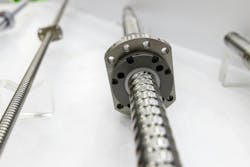How to reduce backlash errors or compensate for mechanical system inaccuracies
July 3, 2024
4 min read
A Control Design reader writes: We generally use ball screws for our motion applications because the conveyance systems we build require precision and speed. What other options are available for reducing backlash? Is there a formula for determining backlash based on load capacity?
Answers
4 ways to reduce backlash errors
When you need to achieve high precision and speed simultaneously, a ball screw drive mechanism isn’t necessarily the best option. Reversing the direction of motion induces backlash, which shows up on a metrology plot as lost motion. In other words, as the ball screw’s direction of rotation is changed from clockwise to counterclockwise, or vice versa, there is a finite amount of “slop” in the mechanism that can depend on factors, such as the ball screw’s accuracy grade, preload and lubrication. This lost motion results in a reversal error that negatively affects accuracy and repeatability.
Here are four techniques to reduce or eliminate backlash-related errors.
The most effective solution to eliminating backlash is to eliminate the ball screw entirely and instead opt for a direct-drive solution. Linear motors, for instance, are non-contact drive mechanisms that are capable of extremely high force output, combined with high speeds and smooth motion. For the ultimate smoothness of motion, free from cogging effects and velocity ripple, ironless linear motors are the way to go (Figure 1). However, linear motors aren’t ideal for every application; for instance, linear motors may struggle to perform in vertical orientations in the absence of a counterbalance.
Therefore, when a ball screw drive mechanism is a must, here are a few proven methods by which to reduce backlash:
- Choose a more highly preloaded ball screw. A preload effectively applies force in such a way as to minimize the slop that causes reversal errors.
- Utilize direct feedback mechanisms in your design. For instance, a linear encoder can be used in conjunction with a ball-screw driven stage or actuator to measure the moving carriage’s position directly. The linear encoder therefore “sees” the backlash as position error and provides a signal to the control loop to correct for it.
- Use a controller with backlash compensation capabilities. Backlash-induced reversal errors tend to be repeatable; therefore, they can be measured and compensated out. In essence, when a direction reversal occurs, the controller increases the commanded move distance by the amount of backlash previously measured, thereby offsetting the lost motion.
There are indeed techniques that can be used to estimate backlash in a ball screw. However, in practice, it's simpler and more effective to use empirical methods to determine a backlash value. When you're designing a ball screw into a system or machine, it's best to consult the manufacturer's documentation and leverage the supplier's expertise in loading calculations, backlash estimation and lifetime estimates.
Brian Fink, product manager/ Aerotech
Control-based vs. drive-based lost motion compensation
There are multiple methods of compensating for mechanical system inaccuracies in servo drives and motion controllers.
Many lower cost computer numerical control (CNC) router, plasma and other gantry CNC systems do not offer motion control-based backlash compensation. Usually, these systems command the axes via pulse train outputs to the servo or stepper amplifiers. In this situation, drive-based lost motion compensation can be used to mitigate the impact of backlash, torsion or friction when the axis changes direction.
When cutting a circle without lost motion or backlash compensation, the start points of the quadrants may appear to have streaks or protrusions. This type of defect is caused by motor shaft motion being absorbed by the mechanical systems without load movement. The difference between motor shaft position and load position is considered to be lost motion. Drive-based lost motion compensation can be utilized to minimize the difference between motor shaft and load position.
Most motion controllers offer some form of backlash compensation. Typically, a value equal to expected backlash is entered into the motion control parameters, and the target position of the axis is automatically offset to accommodate backlash or lost motion. While this value is static, backlash is not necessarily constant over the life of the machine. Wear will result in backlash increasing over the life of a system.
The most advanced servo drives offer users the ability to measure backlash during the life of the machine. When the backlash estimation function is used in conjunction with motion controller-based lost motion compensation, positioning accuracy is easily maintained over the life of mechanical system.
Ben Strong, product marketing manager, servo/ Mitsubishi Electric Automation
About the Author
Anna Townshend
Managing Editor
Anna Townshend has been a writer and journalist for 20 years. Previously, she was the editor of Marina Dock Age and International Dredging Review, until she joined Endeavor Business Media in June 2020. She is the managing editor of Control Design and Plant Services.
Sign up for our eNewsletters
Get the latest news and updates

Leaders relevant to this article:

